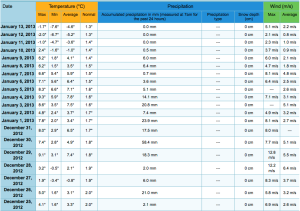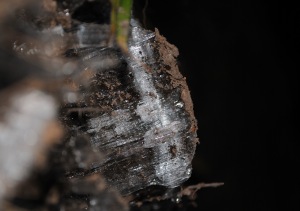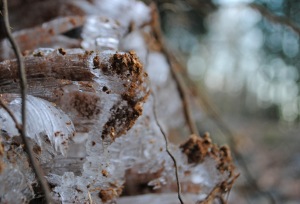It’s been cold in Bergen the past few days. And before that it was wet, very wet. This combination has lead to some interesting effects. For the first time in several years, we have seen the fjord freeze over around town. Usually, this does not happen because of a layer of extra-salty water from salted road run-off. However, with two weeks of mild temperatures and bucket-loads of rain (see table) behind us, the top layer of the fjord is much fresher than usual. Much fresher means much easier to freeze.

2013 started very wet fr Bergen with 183 mm between Dec 28 and Jan 10. Then the temperatures dropped and the ground froze (yr.no).
Up along the mountain sides, less obvious and extremely delicate phenomena have been sprouting up. If soil moisture creeps up over a magical 34% and the temperature drops below 0°C, frozen pins shoot up from the surface. Needles of ice reach upward; usually laden with dirt and soil from the surface below (Rempel, 2012). These ‘ice needles’ are well known phenomena in soil science, but rarely seen in Bergen.

Lifting soil particles up from the surface on ice needles roughly 1mm in diameter. But there’s a lot of them! (c) Mathew Reeve
With the forecast staying under 0°C for the next week, it doesn’t look like these formations will be going anywhere. However when they do melt, the suspended soil particles will fall straight downward and thereby ending up slightly downslope to where they started. At this point, a tiny portion of the mountain side has made it’s way slightly closer to the sea. In my experience, this kind of erosion occurs rarely in Bergen and is of minuscule importance compared with the overwhelming power of huge amounts of rain. In other parts of the world, ice needle erosion is an important factor in hillside erosion, especially in areas where freeze-thaw processes occur on a daily basis. In some studies, ice needle erosion is estimated to account for up to 43% of river bank erosion. One study estimated that if sufficient moisture is present, these seemingly delicate spikes can lift upto 4 kg/m2 (Lawler, 1993).
With quantities such as this, it is not then surprising that soil creep of this nature is the dominant soil transport mechanism on many sub-Antarctic islands. This is especially the case on Marion Island where favourable conditions occur from 60-200 days per year (Nel, 2012).
With the formation of needle ice so dependent on soil moisture and ambient temperature fluctuations, climate change will clearly influence how much of the mountain is moved in this way in the future (Sweeney et al, 2012). The influence of climate change could vary non-linearly due to the interaction of factors such as cloud cover, cyclone paths, precipitation amounts and air pressure (Nel, 2012).
In the meantime, they make a very pretty curiosity for anyone taking a mountain hike in Bergen at the moment.










Pingback: Klimablogg for unge forskere « Uni Research()